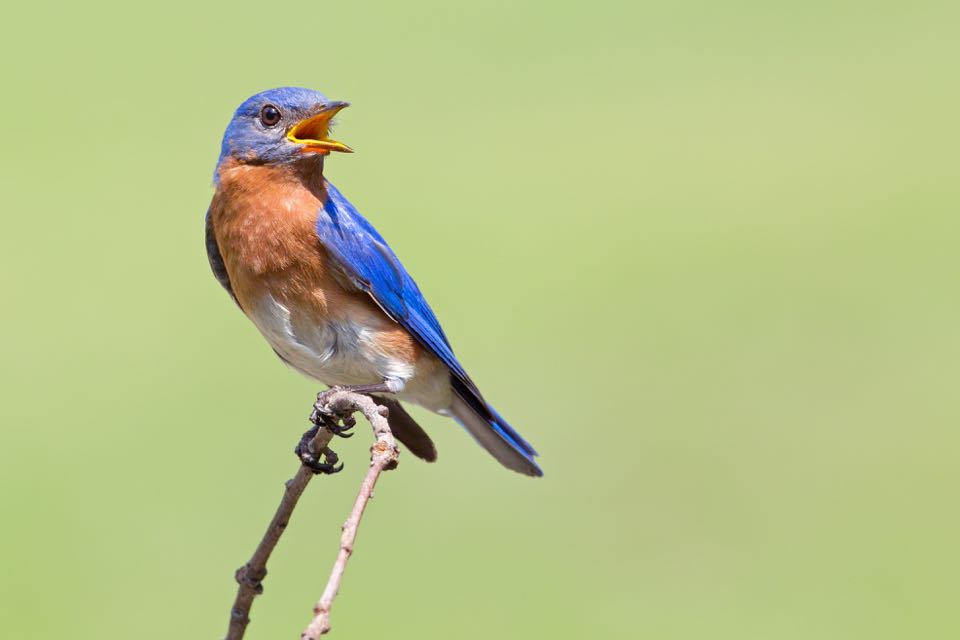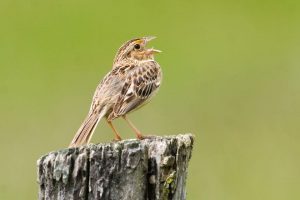By Ashley Peele

Eastern Bluebird (Bob Schamerhorn)
Breeding behaviors and the use of breeding codes to describe these behaviors is probably the most unique, interesting, and important aspect of a Breeding Bird Atlas project. In Virginia, we have a diverse bird community, which makes collecting breeding evidence both fun and challenging. The Atlas handbook provides detailed descriptions of each breeding code, but sometimes it is still a little difficult to know when and how to apply certain codes. In this series of articles, we highlight some of the trickier codes from each category and provide additional information on when to use them and what species they apply to.
For this first installment, we’ll start out with the Observed and Possible codes…
Observed Category:
Observed – no code
If you include a species on your checklist with no breeding code, then it is automatically classified as observed. Observers should be reporting every species they detect on a checklist, so any species for which you have no other evidence of breeding will fall under this code.

American Kestrel in Flight (Bob Schamerhorn)
Flyover – F
This observation applies to species that are observed flying overhead, but not landing anywhere within the block. However, as with all breeding codes, you only want to use this code if you suspect the bird could be breeding in your block. There are several examples of species it should generally not be applied to.
- Swallows and swifts foraging in the air above you – these birds may not obviously land in your block, but they are using the aerial habitat. For this reason, don’t use the F code, unless you see these birds actually passing through.
- Gulls, Terns, Egrets, Herons, and Pelicans – these species range far from their breeding colonies to forage, so a Flyover rarely means they are breeding in your block or even an adjacent block. Avoid using F for these species, unless you have reason to believe there is a breeding colony in your block.
Possible Category:
The Singing Codes – S and S7
(S7 is a Probable code, but the same rules apply to both.)
These codes only apply to species that have a song, vocalization, or produce another sound specifically associated with breeding. Typically, these are given by the male bird and what you’d normally think of as a song. However, there are always a few exceptions to keep Atlasers on their toes. Rather than listing all the species that DO have breeding specific vocalizations, we will focus on those that DO NOT fit into this category. Let’s consider some examples of these…

Grasshopper Sparrow Song (Bob Schamerhorn)
- Waterfowl (ducks, geese, swans, etc.)
- Shorebirds
- Wading Birds
- Vultures
- Pigeons
- Terns, Gulls
- Corvids (jays, crows, ravens)
- Belted Kingfisher
- White-breasted Nuthatch
- Cedar Waxwing
- Common Nighthawk (booming sound produced by male diving behavior can be coded as S)
- Swallows and Swifts (Barn Swallows do sing occasionally, but it is difficult to distinguish from their call.)
- Blue-gray Gnatcatchers (males/females call frequently, but males only rarely sing early in the breeding season).
Allaboutbirds.org is a great website for digging into questions about birds breeding behavior and vocalizations. If you want to really dig in, we can help you get a discounted membership to Birds of North America, the best (in my opinion) online repository for bird life history information.
We’ll pick up our next article with the codes from the Probable category. Remember that your regional coordinator or the Atlas Facebook group are great resources for posting questions about codes. If you’re not sure, just ask!
~Ashley Peele, VABBA2 Coordinator


